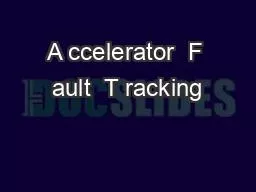

Getting the most out of AFT Chris Roderick amp the AFT Team Daniel Martin Steffen Pade A ccelerator F ault T racking 10122018 httpsindicocerncheaft122018 httpsaftcernch ID: 812102
Download The PPT/PDF document "A ccelerator F ault T racking" is the property of its rightful owner. Permission is granted to download and print the materials on this web site for personal, non-commercial use only, and to display it on your personal computer provided you do not modify the materials and that you retain all copyright notices contained in the materials. By downloading content from our website, you accept the terms of this agreement.
Slide1
Slide2Accelerator Fault Tracking “Getting the most out of AFT”
Chris Roderick & the AFT Team: Daniel Martin, Steffen Pade
Accelerator Fault Tracking
10-12-2018
https://indico.cern.ch/e/aft122018
https://aft.cern.ch
Slide3Background 1/2AFT Project launched in 2014, focus on LHC for start of 2015
3
Track faults in two areas:Directly affecting accelerator operation – identify root causesEquipment faults independently of immediate impact on accelerator operation
Complete & Consistent Tracking will allow to
identify:Problems as early as possible
☞ allowing for timely mitigation
Key issues
which
will
limit performance
of accelerators or equipment (Run3, HL-LHC, …)
Aim:
Increase availability
, both short and long-term, by dealing with issues ASAP
Slide4Background 2/2AFT successfully used for LHC throughout 2015
4
2016 Chamonix workshop - CMAC recommended AFT be extended to cover the Injector Complex for 2017 onwards
AFT successfully used for Injector Complex since start 2017
Slide5Current Status5
Steadily providing new features and improvements
Requested to extend to cover the SPS North Area
>450 users (
~250 regular users)
AFT is the
common source
for
regular performance reporting
:
FOM, LMC, Post TS, Evian etc.
Thanks to the work of the
AFT Team
Daniel Martin
Steffen Pade
Chris Roderick
Slide6Roles & PrivilegesAWG Members (Availability Working Group) &
Machine Supervisors: power users, responsible for overall data quality, arbitrating between operators and equipment groups, producing periodic reports.6
Operators: responsible for initial data entry / edition.
System Experts
: responsible for validating and completing data for faults assigned to their system(s).
All access requires a login via
CERN SSO
.
Other users
:
have read access, are able to comment etc.
Roles use RBAC and are managed via
e-groups
.
Your
role dictates what you can do
inside AFT.
Main Roles:
Slide7R2E-Availability Workshop
AFT High-Level Overview7
10-14-2014
AFT server
Logging System – machine info
Additional systems in future
eLogbook – basic fault data
Storing filtered data coming
from other systems correlated
with faults details entered in AFT
Web interface allowing to browse,
edit and analyse fault data.
Collaboration between operators,
system experts and AWG members
AFT DB
Slide8R2E-Availability Workshop
Operators use E-Logbook for Initial Fault Registration8
10-14-2014
Slide9R2E-Availability Workshop
AFT High-Level Overview9
10-14-2014
AFT server
Logging System – machine info
Additional systems in future
eLogbook – basic fault data
Storing filtered data coming
from other systems correlated
with faults details entered in AFT
Web interface allowing to browse,
edit and analyse fault data.
Collaboration between operators,
system experts and AWG members
AFT DB
Slide10AFT Fault Review Processes
AWG members and Machine coordinators meet periodically (weekly for the injectors) to review the faults:completing missing data, ensuring consistency across the machines, and adding relationships between the faults where applicable.
10
System Experts are notified of new faults either
immediately after they are assigned or periodically (weekly) according to the system experts preferences. Invited to review the faults assigned to their system - essentially acknowledging the fault.Able to update certain attributes.
Can
request modification of remaining attributes
by AWG
(e.g. change of times, states, re-assignment to another system etc.).
Workflow
behind, whereby the
AWG/Machine Coordinators
are able to see and
accept / reject modification requests
.
This is
the best / easiest way to work
- i.e. don’t just send mails or make comments asking for things to be re-assigned (will show an example later).
Slide11Demo11
Daniel Martin
Steffen Pade
Chris Roderick
AWG Role
System Expert
Non-privileged User
For the sake of the demo, 3 browser sessions with different roles:
Slide12R2E-Availability Workshop
Questions - Discussion12
10-14-2014